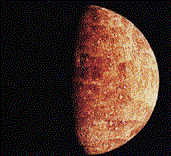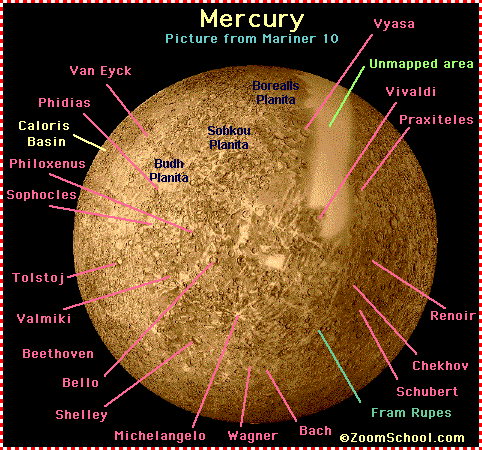MERCURY
Mercury's elliptical orbit
takes the small planet as close as 47 million kilometers (29 million miles) and as far as 70 million kilometers (43 million
miles) from the Sun. If one could stand on the
scorching surface of Mercury when it is at its closest point to  the Sun, our star would appear more than three times as large as it does when viewed from Earth. Temperatures on Mercury's
surface can reach 430°C (800°F).
the Sun, our star would appear more than three times as large as it does when viewed from Earth. Temperatures on Mercury's
surface can reach 430°C (800°F).
Because the planet has
no atmosphere to retain that heat, nighttime temperatures on the surface can drop to -180°C (-290°F). Because Mercury is so
close to the Sun, it is hard to directly observe from Earth except sunrise or sunset.
Mercury makes an appearance indirectly, however - 13 times each
century, Earth observers can watch Mercury pass across the face of the Sun, an event called a transit. The transits fall within
several days of May 8 and November 10. The first two transits of Mercury in the 21st century occurred 7 May 2003 and 8 November
2006. The next will occur on 9 May 2016.
Mercury speeds around
the Sun every 88 days, traveling through space at nearly 50 kilometers (31 miles) per second -- faster than any other planet.
One Mercury solar day equals 175.97 Earth days.
Instead of an atmosphere,
Mercury possesses a thin exosphere made up of atoms blasted off the surface by the solar wind and micrometeoroid impacts.
Because of solar radiation pressure, the atoms quickly escape into space and form a tail of neutral particles. Though Mercury's
magnetic field has just 1 percent the strength of Earth's, the field is very active. The magnetic field in the solar wind
episodically connects to Mercury's field, creating intense magnetic tornadoes that funnel the fast, hot solar wind plasma
down to the surface. When the ions strike the surface, they knock off neutrally charged atoms and send them on a loop high
into the sky.
 Mercury's surface resembles that of Earth's Moon, scarred by many impact craters
resulting from collisions with meteoroids and comets. While there are areas of
smooth terrain, there are also lobe-shaped scarps or cliffs, some hundreds of miles long and soaring up to a mile high, formed
by contraction of the crust. The Caloris basin, one of the largest features on Mercury, is about 1,550 kilometers (960 miles)
in diameter. It was the result of an asteroid impact on the planet's
surface early in the solar system's history. Over the next several billion years, Mercury shrank in radius about 1 to 2 kilometers
(0.6 to 1.2 miles) as the planet cooled after its formation. The outer crust contracted and grew strong enough to prevent
magma from reaching the surface, ending the period of volcanic activity.
Mercury's surface resembles that of Earth's Moon, scarred by many impact craters
resulting from collisions with meteoroids and comets. While there are areas of
smooth terrain, there are also lobe-shaped scarps or cliffs, some hundreds of miles long and soaring up to a mile high, formed
by contraction of the crust. The Caloris basin, one of the largest features on Mercury, is about 1,550 kilometers (960 miles)
in diameter. It was the result of an asteroid impact on the planet's
surface early in the solar system's history. Over the next several billion years, Mercury shrank in radius about 1 to 2 kilometers
(0.6 to 1.2 miles) as the planet cooled after its formation. The outer crust contracted and grew strong enough to prevent
magma from reaching the surface, ending the period of volcanic activity.
Mercury is the second
densest planet after Earth, with a large metallic core having a radius of 1,800 to 1,900 kilometers (1,100 to 1,200 miles),
about 75 percent of the planet's radius. In 2007, researchers used ground-based radars to study the core, and found evidence
that it is molten (liquid). Mercury's outer shell, comparable to Earth's outer shell (called the mantle), is only 500 to 600
kilometers (300 to 400 miles) thick.
The first spacecraft to visit
Mercury was Mariner 10, which imaged about
45 percent of the surface. In 1991, astronomers on Earth using radar observations showed that Mercury may have water ice at
its north and south poles inside deep craters that are perpetually cold. Infalling comets or meteorites might have brought
ice to these regions of Mercury, or water vapor might have outgassed from the interior and frozen out at the poles.
NASA's MESSENGER mission will study and
image Mercury from orbit for one year, mapping nearly the entire planet in color. The spacecraft performed two close flybys
of Mercury in 2008 and another in 2009. By the second flyby, the spacecraft had imaged about 80 percent of the surface at
useful resolution and made discoveries about the magnetic field and how Mercury's crust was formed. The flybys employed Mercury's
gravity to help ease the spacecraft into orbit in March 2011.

How Mercury Got
its Name
Mercury
is appropriately named for the swiftest of the ancient Roman gods. Mercury, the god of commerce, is the Roman counterpart
to the ancient Greek god Hermes, the messenger of the Gods.

